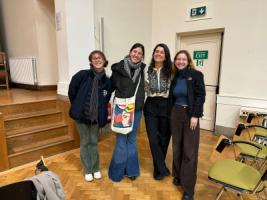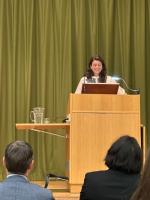
It is a rainy afternoon on the 13th of February and Samanta Schweblin is delivering the 2024 Taylor Lecture to a packed hall. One of the most acclaimed contemporary authors working in Spanish, Schweblin (Buenos Aires, 1978) has been translated into more than 40 languages and has received numerous accolades. Her novel Fever Dream (Distancia de rescate) was shortlisted for the International Man Booker Prize in 2017 and her collection of short stories, Pájaros en la boca (Mouthful of Birds), and her novel Kentukis (Little Eyes) were longlisted for the same prize. In 2022, her short story collection, Seven Empty Houses (Siete casas vacías), translated by Megan McDowell, won the National Book Award for Translated Literature and in 2021, Distancia de rescate was adapted for Netflix by director Claudia Llosa and the author herself. A master of articulating discomfort and pushing the limits of fear, her fiction’s eerie strangeness draws attention to the oddness of the everyday, and the crises we face on a personal, as well as a global, level.
Fascinated by how narrative machinery works, in this lecture, Schweblin explores how fiction emerges from the tensions and interplay between the writer's use of language and the reader's imagination. This begins with the power of words and their evocation. Schweblin takes the sentence: ‘there is no teapot on the table’. In the audience, not only do we choose a specific teapot, but we undertake the almost impossible effort of making it disappear. The writer provokes, the reader reacts. The writer takes one step, the reader takes another, and it is this dance that allows a narrative to form.
Schweblin has run many creative writing workshops over the years and uses them as a way of testing this imaginative power. Imagine you are at the beach with mum and dad, she says. What do you see? In her workshops, the group would draw this on paper, but as an audience we are asked to imagine it. Almost everyone she has done this with draws a line. Above is the ocean and sky, below is the beach. All draw a sun, it is always daytime, and it is always hot. Writing ‘you are at the beach with mum and dad’, generates a set of assumptions, and the reader takes these, invoking their imagination, to fill the page. The writer takes one step, the reader takes another, they are dancing.
However, if a writer chooses to say ‘you are at the beach with mum and dad. It is night-time’, in that second sentence, the writer has stepped on the reader. Schweblin notes that this is not necessarily a bad thing, but creates, what she calls, resistance. Friction occurs when the reader is forced to change their assumptions and this, like dance etiquette, must be considered. You can’t push too hard or infringe on someone’s space or you risk dancing alone. Does a writer have control over what a reader thinks? Is what a reader first imagines what is intended by the narrative? Schweblin says that she writes with this in mind: as an author, what do I want to say? And what do I want you to understand? She seems to break the fourth wall when she acknowledges that, in the academic world, it is easy to say things and forget that we are saying them to someone. It is important to keep the reader, or audience, in mind.

To further demonstrate her point, Schweblin tells us a story told to her by a university professor. Crucially, she points out, it is based on true events. The story is of two couples, Danish and Australian, who meet in the parking lot of a haunted house for adults. They become friends and go in the haunted house together. However, after veering off the intended route, they end up in a basement where the horror no longer seems staged. What follows is the Danish couple’s account because the Australians do not survive.
The audience is left in suspense. Schweblin points out that this is when a reader, or listener, is most attentive. Tension is attention. So, what happens in that split second when the reader is suspended, in the basement, with the Danish and Australian couples? The dance between reader and writer that Schweblin has so magically described is playing out in real time. Now, it is between speaker and listener. We are all on the edge of our seats. Perhaps it is here, Schweblin hypothesises, in this state of uncertainty, in this instant of not knowing at all, with the anticipation of a new and vital piece of information being delivered, where we find the true pleasure in reading.
In the basement, the couples see two teenagers trapped in a cage. The door behind them slams, they are trapped in the basement with a man wielding a chainsaw. The audience can guess how this ends. The professor who told Schweblin this story is Mathias Clasen and the story narrates an experiment he set up to explore the physical and mental effects fear has on humans. But, how do you get an authentic reaction from a volunteer (the Danish couple in this case) who knows they are taking part in an experiment and has consented to being scared? By resorting to fiction. Here, Schweblin delivers the vital piece of information that makes the whole story fall into place: the Australian couple are actors. If you make a friend, Schweblin says, there is nothing more real than that friend, and therefore anything that happens to that friend is, by implication, real. When we hear this story, we fall into what Clasen calls the ‘horror paradox’: reading ‘so horrifying that you won’t be able to finish it’ on the cover of a book is, ironically, the reason you won’t be able to stop reading it. We simultaneously expect the worse and want it to happen. But what does this story have to do with a reader’s imagination? Schweblin tells us that by exposing ourselves to fear, we are measuring our ability to deal with it. If we can come away from a horror film scenario unscathed, perhaps our way of seeing the world, or of seeing ourselves, changes. This is the power of fiction.
Schweblin concludes by revealing that if her goal as an author is to transmit a felt emotion as faithfully as possible to a reader, she cannot put her own desires of what she wants to say first. Literature happens during the process of reading. If there is only one side to the process, we go in circles. The only way to move towards something is by giving room to that other movement that we sense but that someone else must make, even if this movement spans decades or centuries. There must be someone waiting to be listened to, and there must be another open to paying true attention, just as has been the case between Samanta Schweblin and her audience today.